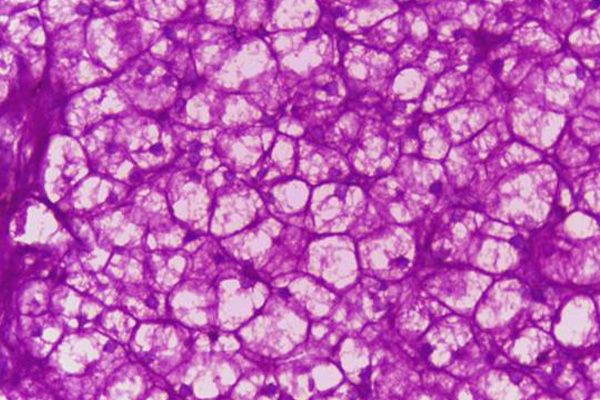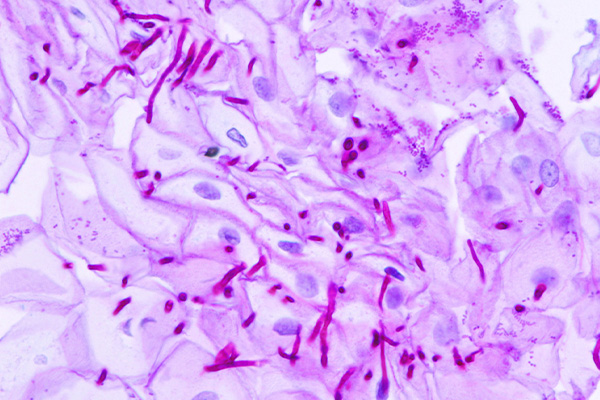Schiff’s reagent reactions, also known as Schiff Tests, can be used to visualize aldehydes in a tissue sample.
Introduction
Schiff’s reagent, also known as fuchsin-sulphurous acid, is a solution that will combine chemically with aldehydes to form a bright red product. Strictly speaking, ketones also react but for all practical purposes they can be ignored. Many tissue components can be stained this way. Schiff’s reagent is made from pararosanilin treated with sulphurous acid. This causes a disruption of the chromophore by the addition of a sulphonic acid group to the central carbon. The sulphurous acid is produced by dissolving sulphur dioxide in water.
Types of Reactions
Periodic Acid-Schiff (PAS) Reaction
The most common application for Schiff’s reagent is the Periodic Acid Schiff reaction for demonstrating carbohydrates in tissue sections.
Nucleal Reaction
Given its sensitivity towards detecting aldehydes, Schiff’s reagent can be used to demonstrate deoxyribosenucleic acid (DNA), especially in contrast to unstained ribosenucleic acid (RNA).
Plasmal Reaction
The plasmal reaction can be used to demonstrate plasmalogens to visualize myelin.
Aldehyde-Schiff Reaction
By targeting amino groups, Schiff’s reagent can be used to demonstrate proteins in a tissue sample.
Schiff’s Reagent Formulations
There are numerous variants or formulations of Schiff’s reagent that may be used for demonstrating aldehydes in samples. Find formulation details, including detailed steps for preparation, storage considerations, and reaction notes for over 10 variants below.
Alternatives to Schiff’s Reagents
While reactions with Schiff’s reagent are the most common way of staining aldehydes, there are alternative methods. For example, a silver reduction reaction is a popular method for the demonstration of fungi and basement membranes. Other alternatives for demonstrating aldehydes include diazonium coupling, osmium reduction, or thiosemicarbazide reduction.
Protocols
Find step-by-step instructions to complete a variety of Schiff’s reagent reactions, with detailed protocols for tissue preparation, staining, and supplementary procedures.
References
- Pearse, A. G. E., (1968, 1972)
Histochemistry: Theoretical and Applied, Ed. 3
Churchill Livingstone, Edinburgh, London, UK - Kiernan. J.A., (1999)
Histological and histochemical methods: Theory and practice, Ed. 3
Butterworth Heinemann, Oxford, UK. - Culling C.F.A., (1974)
Handbook of histopathological and histochemical techniques Ed. 3
Butterworth, London, UK.
Citing:
Kasten, F.H., (1958), Stain Technology, vol.33, pp.39
Kasten, F.H., (1959), Histochemie, vol.1, pp.466 - Lillie, R.D., (1954)
Histopathologic technique and practical histochemistry Ed.2
Blakiston, New York, USA.








